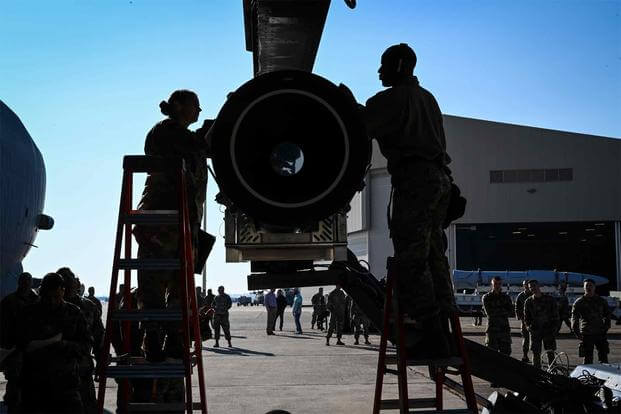Airmen at Barksdale Air Force Base in Louisiana have figured out how to attach the service's new hypersonic missile to an aircraft, a major hurdle in getting the weapon produced.
The Air Force's Air-Launched Rapid Response Weapon, known as the ARRW, uses a rocket booster to glide the missile toward an area at breakneck speed before a glider separates to hit a target. Airmen at Barksdale's 2nd Maintenance Group, 307th Aircraft Maintenance Squadron through "trial and error" have finalized how they will attach and unload the weapon from an aircraft, a Thursday news release from the base said.
"With the validation of loading and unloading procedures, the weapon can start live fire testing and then production," Barksdale Air Force Base said in the release. "The weapon is scheduled to be operational in fall 2023."
Read Next: New Court Ruling Slams Air Force's Limited Approval of Religious Exemptions for COVID-19 Vaccine
This past May, the Air Force successfully tested the Lockheed Martin-developed ARRW hypersonic missile off the California coast, a major development in the United States' race to catch up to Russia and China in fielding its own weapon on the battlefield. Prior to that launch, the service had three unsuccessful hypersonic missile tests.
Jeffrey Lewis, a professor at the Middlebury Institute for International Studies who specializes in nonproliferation and arms control issues, told Military.com on Thursday that hypersonics are a pretty exotic capability. While it's notable that the service is making progress, it's unclear how they plan to deploy the technology in battle.
"I do think if they work on it long enough, it's going to work," Lewis told Military.com. "The successful test suggests that they're making progress. I still think they're going to be fairly niche capabilities. It's an open question as to how much value it will produce."
Hypersonic missiles' high speeds make them difficult to track, trace and destroy before hitting a target. Some defense industry experts have publicly assessed that adversaries like China and Russia have outpaced America in developing the weapons.
In March, Russia's defense ministry claimed its military used hypersonic missiles against an underground ammunition warehouse as well as a fuel depot during the country's fighting in Ukraine. It would mark the first time a country had used such a weapon in combat.
U.S. military officials largely downplayed their use in Ukraine, with Defense Secretary Lloyd Austin telling CBS he "would not see it as a game changer." Similarly, Joint Chiefs of Staff Chairman Gen. Mark Milley said during a House Appropriations defense subcommittee hearing on May 11 that Russia's use of hypersonics was not really significant.
Russia has used at least a dozen hypersonic missiles in its invasion of Ukraine, according to a U.S. senior military official.
Last year, military officials confirmed China had a successful hypersonic launch that had circumnavigated the globe.
Hypersonic missiles -- some of which have nuclear-carrying capabilities -- often have nearly the same effect on a ground target as conventional bombs, making the use of the prohibitively expensive weapons surprising.
But that hasn't stopped the U.S. from prioritizing research and development into the new class of weapons. In 2022, lawmakers approved $509 million for hypersonics. That number has grown to $577 million in the 2023 budget proposal.
-- Thomas Novelly can be reached at thomas.novelly@military.com. Follow him on Twitter @TomNovelly.
Related: Air Force Tests Hypersonic Missile Amid Fears About Russia and China's Advances












